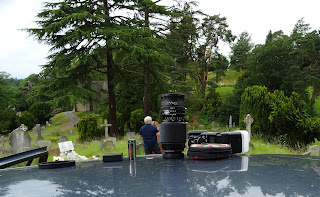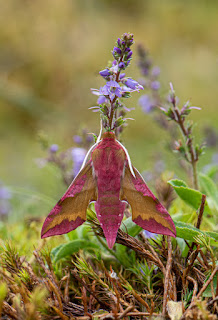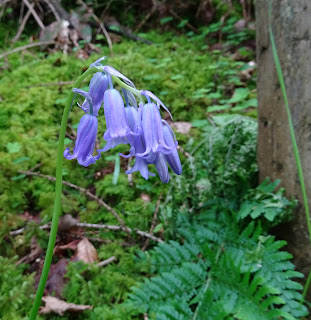Bridgnorth Cemetery, Wednesday 19th June 2019
After our second wash-out of the year the previous Wednesday we looked forward to a day in the sun and warmth at Bridgnorth Cemetery.
Looking forward to and reality do not always agree but on this occasion, apart from a few insignificant drops of rain and some rather large clouds, they did, providing welcome relief from the run of poor weather that has dogged us this month.
The day did not start well. The area we were going to park in was cordoned off due to "essential tree work" and all the obvious parking spaces within the cemetery were taken up by Bridgnorth Council vehicles. Eventually we parked in front of one of the chapels hoping that it was not going to be needed during the day.
The cemetery appeared to be in two halves. The first section where the graves seemed to be arranged in a random pattern with the vegetation allowed to prosper:
And the second with the graves in neat rows:
We spent most of our time wandering around the first section as the longer vegetation is more attractive to insects giving them areas to feed, breed and hide. Also the older headstones are often colonised by lichens:
 |
| Photograph: Bob Kemp |
Lichens form communities on the stones and as with other life forms some lichens predate on others to gain the resources they need to survive:
 |
| Photograph: Bob Kemp |
In the photograph above the lichen on the right is a Cladonia and the one on the left is Diploschistes muscorum which is attacking the Cladonia for its algae to help it develop.
Many insects feed on algae and others use it for shelter. On another stone a host of mites could be seen around and on a lichen:
 |
| Photograph: Bob Kemp |
Lichens and the stones they are on also provide excellent backgrounds for photographs. I cannot vouch for whether the following insect were found on the surfaces they were photographed on or placed there for the background effect:
A Chequered click beetle - Prosternon tessellatum
 |
| Photograph: Bob Kemp |
 |
| Photograph: Bob Kemp |
 |
| Photograph: David Williams |
 |
| Photograph: Bob Kemp |
And a moth that was new to me - a Bird's-wing moth.
Where there are stones aggregated into a structure there will be gaps between them which can be exploited. One such exploiter is a spider of the genus Amaurobius which builds its web across the holes and cracks and waits for its victims in the space behind. It can be enticed out of its lair by the judicious use of an electric toothbrush on the web.
The day was not all about stones, lichens and using them as background for photographs or teasing out spiders, we did search the vegetation and the trees.
The day saw the debut of a new piece of machinery to help our searches: the battery powered leaf blower. As with the petrol version it can be plumbed to suck rather than blow. This was used extensively until the bag used to collect the material split. After that we had to resort to our old favourite the moth-vac.
The battery-vac has a much smaller nozzle which may lead to reduced catches but it is about a quarter of the weight of the moth-vac and easier to handle making it a very attractive piece of equipment. I will try to include a picture of it in action in a later report.
Back to the animals that we found.
Great excitement from our Spider-Man greeted the discovery of this harvestman:
This is Homalenotus quadridentatus and was only the second time it had been found in the county.
We found a host on nymphs and larvae.
Firstly a couple of ladybird larvae.
A very ornate larva that develops into a small yellow and black ladybird common in grassland - a 24-spot ladybird:
A more plain one that will develop into a large red and black ladybird that lives primarily in Scot's pine - a Cream-streaked ladybird:
 |
| Photograph: David Williams |
The day was not all about stones, lichens and using them as background for photographs or teasing out spiders, we did search the vegetation and the trees.
The day saw the debut of a new piece of machinery to help our searches: the battery powered leaf blower. As with the petrol version it can be plumbed to suck rather than blow. This was used extensively until the bag used to collect the material split. After that we had to resort to our old favourite the moth-vac.
The battery-vac has a much smaller nozzle which may lead to reduced catches but it is about a quarter of the weight of the moth-vac and easier to handle making it a very attractive piece of equipment. I will try to include a picture of it in action in a later report.
Back to the animals that we found.
Great excitement from our Spider-Man greeted the discovery of this harvestman:
 |
| Photograph: David Williams |
We found a host on nymphs and larvae.
Firstly a couple of ladybird larvae.
A very ornate larva that develops into a small yellow and black ladybird common in grassland - a 24-spot ladybird:
 |
| Photograph: David Williams |
And finally in this kiddies section some grasshoppers and their relations.
A meadow grasshopper:
An oak bush cricket:
A meadow grasshopper:
 |
| Photograph: David Williams |
 |
| Photograph: David Williams |
 |
| Photograph: David Williams |
Here are a few.
The moth vac was very effective at finding a number of Bordered shieldbugs. These are normally quite elusive but when one is found you may well find several. And so it proved here when half a dozen or so were found.
 |
| Photograph: David Williams |
 |
| Photograph: David Williams |
 |
| Photograph: David Williams |
 |
| Photograph: David William |
And finally I hope that the driver of this car before driving off remembered that he had put his photographic equipment on the roof.
Until next time, Bye!
Thank you to Bridgnorth Council and the staff at the Cemetery for letting us do what we enjoy doing; to Caring for God's Acre for making all the arrangements and to the photographers David Williams and Bob Kemp for providing their photographs for me to use.





























































